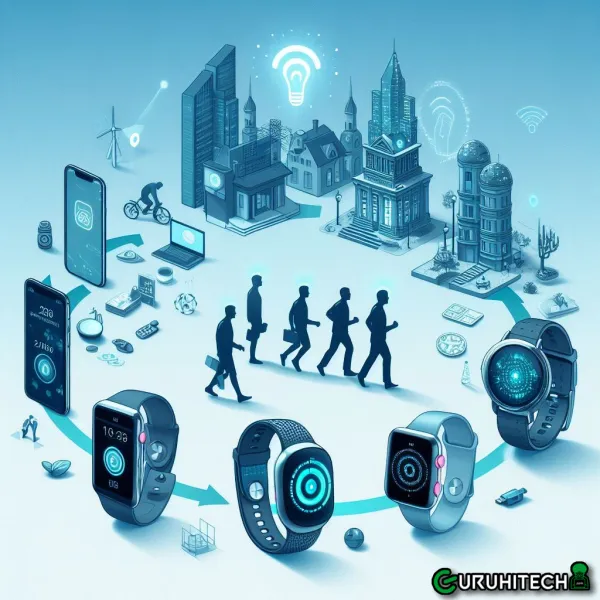Evolution of smart personal safety devices: from wearables to AI-powered solutions

In the contemporary era, where personal security is a major concern worldwide, smart devices have transformed our view of it. They are equipped with different advancements that make them completely safe from diverse risks, whether indoors or outdoors.
Smart personal safety devices for individual safety or wearables and AI-driven solutions extend beyond conventional security approaches by adopting sophisticated technologies for real-time monitoring, emergency services, and proactive threat identification. There are various examples, from wearable gadgets like smartwatches and fitness trackers to high-end AI-based systems; such devices make it possible for people to ensure their own safety in today’s ever-more intricate world.
Smart Personal Safety Devices Market
There has been a monumental shift in the market of smart personal safety devices within the last few years, as this happened due to the rise in the need for creative solutions aimed at addressing security concerns. Smart personal safety devices have emerged as vital tools that enhance individual safety and security in the form of wearable and AI-based technologies.
Further growth and diversification are expected in the market for smart personal safety products owing to technological advancements allowing their creation. Thus, the next generation promises personalized safety solutions based on interconnectedness, biometric authentication, or augmented reality integration that fits into modern consumers’ preferences.
1. The Rise of Wearables:
- Wearable technology, like smartwatches and fitness trackers, first incorporated safety features into everyday accessories. The Apple Watch included emergency fall detection and SOS calling to notify emergency services and contacts in case of an emergency. As the demand for personal safety grew, wearable manufacturers began integrating features where users can practice cpr courses techniques or learn how to administer basic first aid through immersive experiences provided by wearable tech.
- Initial versions had basic features like panic buttons for emergencies. Fitbit had a popular fitness tracker with a feature to alert three contacts in emergencies with the press of a button.
Further developments involved a GPS tracking system, fall sensing capability, and SOS alerts, among other things, which highly improved user safety and ensured peace of mind. Samsung Galaxy Watch, for example, comes with built-in GPS tracking so that one can keep track of his/her location in real-time, thus sharing it with trusted contacts for added safety when performing outdoor activities.

2. The Integration of Connectivity:
- Bluetooth and Wi-Fi connections quickly allowed wearables to sync with smartphones. This meant instant alerts and remote monitoring became possible. For instance, the Garmin Vivosmart 4 can receive calls and messages from WhatsApp on the wrist thanks to its link with the Garmin Connect app.
- To ensure crucial information like medical records and emergency contacts are always on hand, cloud storage and data syncing are essential. The Oura Ring, for example, stores health and sleep data in the cloud to help users track their well-being accurately.
3. The Emergence of AI-powered Solutions:
- Artificial intelligence has transformed personal safety devices by using advanced algorithms for real-time threat detection and response. Firms like Athena Security use AI-powered security cameras with facial recognition to detect threats instantly and alert authorities.
- Predictive analytics models driven by AI can forecast potential risks by analyzing user behavior and environmental conditions, giving proactive alerts and recommendations. The Nest Protect alarm, for example, uses AI algorithms to analyze smoke and CO levels, providing early warnings before a dangerous situation arises.
4. The Future of Personal Safety:
- The use of augmented reality (AR) technology can enhance users’ situational awareness by providing real-time information in their surroundings. For instance, Microsoft HoloLens AR glasses can help firefighters by giving them information about building layouts and potential risks, improving their safety during rescue operations.
- Biometric authentication ensures secure access to important features and information, protecting users’ data. Apple Watch uses biometric techniques like Face ID and Touch ID to keep authorized health data secure on the device.
Furthermore, interconnectivity with smart home appliances can enable automatic responses to threats to personal safety by unifying personal safety devices into a larger network of home protection. In this regard, Ring Alarm is an example of a smart home security system that can work in tandem with other devices, such as smart locks and surveillance cameras, providing all-inclusive coverage against intruders and other threats.
Conclusion:
In summary, there are many ways that these technologies are transforming our sense of personal safety through the evolution towards smart solutions. These wearable technologies have changed from simple functions to advanced AI devices, thereby significantly improving our capability to protect ourselves and our families in an ever more complicated world. It’s worth noting that technological advancement offers unlimited room for creativity and integration in the future while still making personal safety remain among the top priority issues anywhere people may be found in this world.
Ti potrebbe interessare:
Segui guruhitech su:
- Google News: bit.ly/gurugooglenews
- Telegram: t.me/guruhitech
- X (Twitter): x.com/guruhitech1
- Bluesky: bsky.app/profile/guruhitech.bsky.social
- GETTR: gettr.com/user/guruhitech
- Rumble: rumble.com/user/guruhitech
- VKontakte: vk.com/guruhitech
- MeWe: mewe.com/i/guruhitech
- Skype: live:.cid.d4cf3836b772da8a
- WhatsApp: bit.ly/whatsappguruhitech
Esprimi il tuo parere!
Ti è piaciuto questo articolo? Lascia un commento nell’apposita sezione che trovi più in basso e se ti va, iscriviti alla newsletter.
Per qualsiasi domanda, informazione o assistenza nel mondo della tecnologia, puoi inviare una email all’indirizzo [email protected].
Scopri di più da GuruHiTech
Abbonati per ricevere gli ultimi articoli inviati alla tua e-mail.
